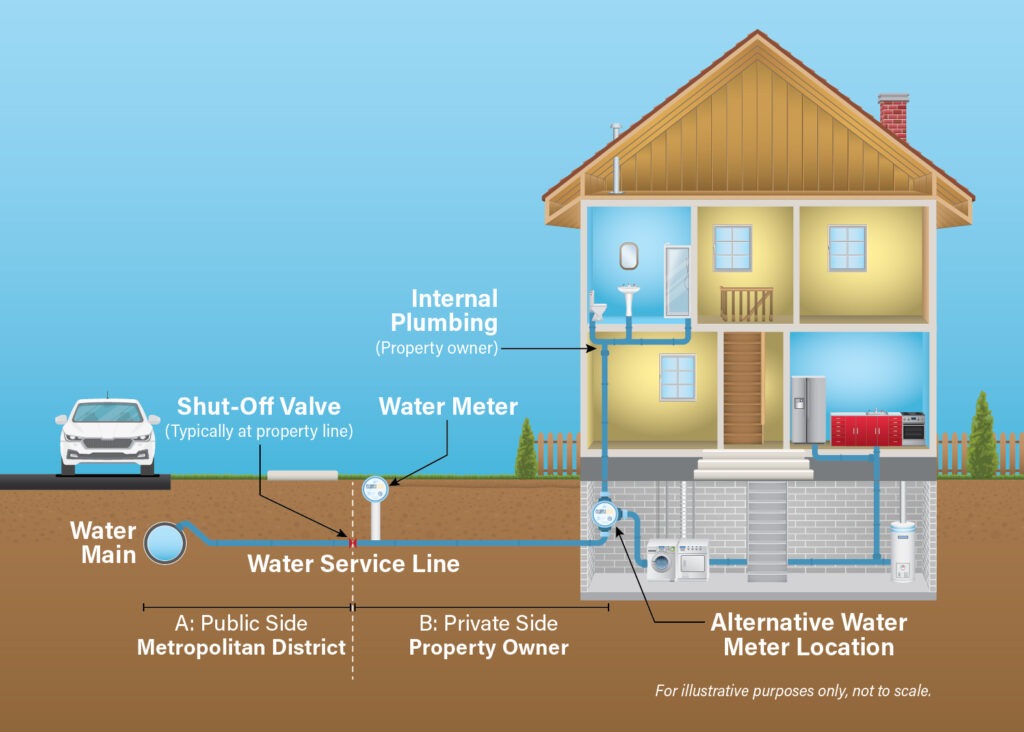
KEEPING LEAD OUT OF DRINKING WATER
What You Need to Know About Lead and Drinking Water
The Metropolitan District (MDC) is committed to providing clean and safe drinking water to our customers. Lead in drinking water can be harmful to human health. Your drinking water does not have lead in it when it leaves our treatment plants. But, lead service lines and lead in older internal plumbing fixtures can cause lead to enter your drinking water.
The U.S. Environmental Protection Agency (EPA) regulates the water treatment process to minimize the possibility of lead leaching into the drinking water. The MDC’s drinking water is treated with chemicals (an orthophosphate-polyphosphate blend ) which help reduce the likelihood of metals being dissolved into the water (corrosion) within the water pipes and plumbing as it makes its way to your faucet. The chemicals are added at levels approved by the State of Connecticut Department of Public Health, Drinking Water Section. The addition of the corrosion control blend and the adjustment of the pH of the water, minimize the potential leaching of lead from residential plumbing which occurs during periods when the water is stagnant.
While the safety of our water has not changed, EPA did change its Lead and Copper Rule in 2021. The revised rule requires us to take action to ensure MDC’s drinking water is lead free. We need your help to find and remove lead in the system. Read on to learn more.
Water Service Line Identification Information materials
Press Release: MDC Announces Compliance With New EPA Lead Rules
Postcard mailer
“Sorry We Missed You” Doortag
Water Service Line Inventory
MDC has completed an inventory of all water service lines to rule out the presence of lead in the pipes to comply with the revised Lead and Copper Rule. A water service line is the pipe that brings water from the water main in the street into your property. Our inventory includes the part of the service line between the water main and the property line and the part of the service line between the property line and the plumbing inside the building.

Many service lines have unknown materials and may require digging at the property line or help from the property owner to identify the material. Older homes and buildings, especially those built before 1990, may still have internal plumbing and fixtures with lead. If your home was built before 1990, you may have a lead service line on the private side of the meter.
Search for your property with our online Water Service Line Inventory Map
https://themdc.org/drinking-water/water-service-line-inventory/
We need your help to identify your service line material if it is Unknown. Learn how:
Use Our Online Self-Reporting Survey
If the Customer Side material is listed as “Unknown”, follow the instructions here to report your service line material.
https://themdc.org/drinking-water/identify-your-water-service-line/
Contact us to schedule an inspection
If you would like an MDC representative to help identify a service with an “Unknown” Customer Side Material, call 860-808-2347 or email [email protected]m to schedule an inspection.
If the Utility Side Material is listed as “Unknown”, MDC will contact you to investigate this service.
What You Can Do
Lead Health Effects
Too much lead in your body can cause serious health risks. The greatest risk is to young children (especially under the age of six) and pregnant and or/breastfeeding women. Ingesting lead can slow a child’s mental and physical development, creating new learning and behavioral problems. In adults, lead can lead to increased risks of heart disease, high blood pressure, kidney, or nervous system problems.
How to Protect Yourself
You can follow the steps below to reduce lead in your drinking water:
- Run cold water before using. The longer the water stays in the plumbing, the more lead it may have. If the water in the faucet has been sitting for more than 6 hours, run water for 3 to 5 minutes before using it. Showering and flushing the toilet also help clear out your water line.
- Replace your home’s internal plumbing that may have lead. Potential lead sources include lead pipes, lead-based solder, and brass fixtures and valves (including faucets).
- Use cold water for cooking, drinking, and making baby formula. Lead dissolves into hot water more easily than cold water. If you need hot water, draw cold water and then heat it. It is safe to shower, wash dishes, and do laundry with hot water from the tap. Lead does not affect humans through the skin. Boiling water does NOT reduce lead.
- Remove and clean faucet strainers. Every 3 months, remove and clean strainers at the tip of faucets to remove build up.
- Remove the faucet strainers from all taps.
- Rinse the faucet strainers.
- Run the water without strainers for 3 to 5 minutes.
- Replace faucet strainers.
- Test your water for lead. You can use a State of Connecticut Department of Health certified laboratory to test your drinking water: Approved Commercial Laboratories.
- Test your child’s blood for lead. Your local doctor or pediatrician can perform a blood test for lead and provide you with information about the health effects of lead. To learn more, including where you can have your child’s blood tested, call the Connecticut Department of Public Health Childhood Lead Poisoning Prevention Program at 860-509-7299.
- Use filters. Use a pitcher filter that is approved to reduce lead (NSF 53-certified). Visit EPA’s website to learn more about water filters.
What the MDC Does
Water Quality Testing
MDC’s state-licensed Water Analysis Laboratory conducts frequent water quality testing at MDC’s reservoirs, treatment plants, and approved sampling locations. With the collected data, MDC prepares an annual MDC Water Quality Report following federal and state regulations. The MDC Water Quality Report provides a summary of water quality and how the MDC collects, treats, and delivers drinking water.
Learn more and read the MDC Water Quality Reports here: MDC Water Quality
In addition to the previously mentioned corrosion control and treatment, the MDC routinely tests for lead in drinking water from residential homes throughout our distribution system in compliance with EPA standards. The latest results show that drinking water supplied by MDC meets all of State of Connecticut Public Health Code and EPA standards for water quality.
Check out our lead compliance results here: 2023
2023
2020
2017
2014
2011
EPA Lead and Copper Rule
EPA released the Lead and Copper Rule in 1991 to protect people from lead in drinking water. The U.S. EPA released Lead and Copper Rule Revisions on October 16, 2021, which aim to better protect children and communities at risk for lead exposure. Water utilities must comply with the revised rule by October 16, 2024. The Lead and Copper Rule Revisions outline actions including:
- Create a materials inventory of all service lines – public and private
- Update/expand how many water samples utilities test each year
- Prepare a sampling plan for schools and licensed daycares
- Review and/or develop a corrosion control program
Learn more
You can learn more about lead in drinking water from the following resources below:
Questions and Answers About Lead and Drinking Water
1. What is a water service line?
A water service line is a small, buried pipe that brings water from water mains in the streets into homes and other buildings.
2. What are the health effects of lead?
Exposure to lead in drinking water can cause serious health effects in all age groups. Infants and children can have decreases in IQ and attention span. Lead exposure can lead to new learning and behavior problems or exacerbate existing learning and behavior problems. The children of women who are exposed to lead before or during pregnancy can have increased risk of these adverse health effects. Adults can have increased risks of heart disease, high blood pressure, kidney or nervous system problems.
3. Is there a safe level of lead exposure?
No, there is no safe level of lead exposure. Any amount of lead exposure has risk.
4. What steps can I take to protect myself if I think I have lead in my water?
a. Run cold water before using. The longer the water stays in the plumbing, the more lead it may have. If the water in the faucet has been sitting for more than 6 hours, run water for 3 to 5 minutes before using it. Showering and flushing the toilet also help clear out your water line.
b. Replace your home’s internal plumbing that may have lead. Potential lead sources include lead pipes, lead-based solder, and brass fixtures and valves (including faucets).
c. Use cold water for cooking, drinking, and making baby formula. Lead dissolves into hot water more easily than cold water. If you need hot water, draw cold water and then heat it. It is safe to shower, wash dishes, and do laundry with hot water from the tap. Lead does not affect humans through the skin. Boiling water does NOT reduce lead.
d. Remove and clean faucet strainers. Every 3 months, remove and clean strainers at the tip of faucets to remove build up.
1. Remove faucet strainers from all taps
2. Rinse the faucet strainers.
3. Run the water without strainers for 3 to 5 minutes.
4. Replace faucet strainers.
e. Test your water for lead. You can use a State of Connecticut Department of Health certified laboratory to test your drinking water: Approved Commercial Laboratories.
f. Test your child’s blood for lead. Your local doctor or pediatrician can perform a blood test for lead and provide you with information about the health effects of lead. To learn more, including where you can have your child’s blood tested, call the Connecticut Department of Public Health Childhood Lead Poisoning Prevention Program at 860-509-7299.
g. Use filters. Use a pitcher filter that is approved to reduce lead (NSF 53-certified). Visit EPA’s website to learn more about water filters.
6. Who is responsible for the water service line on my property?
The water utility is responsible for the service line from the water main in the street to the property line. The property owner is responsible for the service line from the property line to the plumbing inside your home.

7. How does lead get into drinking water?
There can be lead in water service lines, plumbing fixtures (faucets, valves, fittings, etc.), and indoor copper plumbing pipes with lead solder. Lead can enter drinking water from plumbing inside your building or the water service line between the street and building. When water sits in the service line or plumbing for hours without use, like overnight, lead may release into the water.
8. Why might the water service line or plumbing fixtures at my home have lead?
Lead used to be common in water service lines and home plumbing. Older homes and buildings, especially those built before 1990, may still have service lines and internal plumbing and fixtures with lead. The U.S. EPA allowed “Lead free” plumbing fixtures to have up to 8% lead until 2014. A licensed plumber can help figure out if you have lead in your indoor plumbing. You can also use an U.S. EPA-approved lead test kit: EPA-approved Lead Test Kit to test the plumbing material.
9. What is corrosion control?
Corrosion control is chemically treating water to help reduce the amount of lead that releases into water from plumbing and pipes. An example is adding a chemical to the water supply that coats service lines. The coating reduces the amount of lead releasing from the lines into a home’s water.
EPA’s website